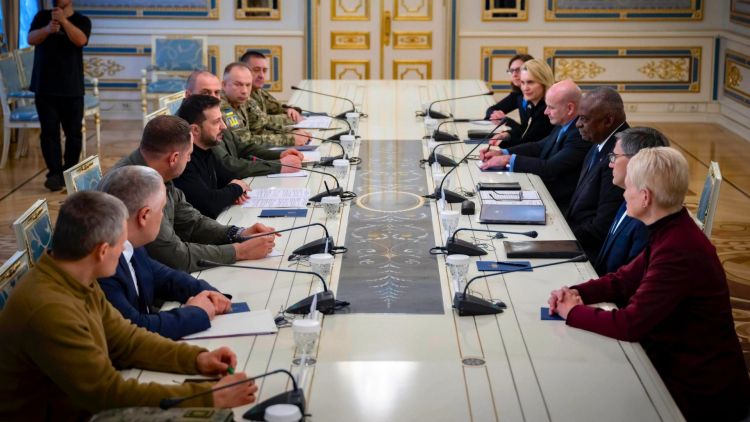As the war in Ukraine approaches its third year since Russia’s invasion in February 2022, President Volodymyr Zelensky is ramping up efforts to promote his ambitious “victory plan.”
According to reports, this multi-point strategy aims to bolster Kyiv’s defenses and secure a favorable outcome in the conflict.
At the heart of the plan is a push for an immediate invitation to join NATO, signaling a shift in strategy that places heavy emphasis on integrating with Western allies.
Despite Zelensky’s determination, however, the United States has shown little enthusiasm for the proposal, nor has it taken a leading role in driving the conflict toward a resolution. This reluctance reflects broader uncertainties among NATO members and raises questions about the best path forward for a war that has dragged on longer than many expected.
Here’s what we have gathered and learned so far about the matter.
A War Dragging Into Its Third Year
The war between Ukraine and Russia has transformed the geopolitical landscape in Europe, forcing millions of Ukrainians to flee their homes, devastating entire cities, and leaving thousands dead.
For Zelensky and his administration, the stakes couldn’t be higher, and his “victory plan” is an attempt to seize the initiative after years of fighting.
While the West has poured military and financial aid into Ukraine’s war effort—sending advanced rocket systems, tanks, and billions of dollars in support—it still hasn’t been enough to decisively shift the balance of power.
Ukraine has made impressive gains, but it continues to struggle against Russia’s larger and better-resourced military. As winter approaches, Russian forces have made slow but steady advances in eastern Ukraine, including the capture of towns like Vuhledar.
These developments underscore that while Ukraine has undoubtedly surprised the world with its resilience, it is still locked in a costly war of attrition.
The ongoing fighting, nearing its 32nd month, is sapping Kyiv’s strength and placing immense pressure on its government to deliver a breakthrough.
The Elusive Promise of NATO Membership
Zelensky’s most recent push centers on securing an invitation to NATO—a goal he sees as crucial for Ukraine’s future security and leverage in any peace talks.
His argument is straightforward: if Ukraine is already cooperating closely with NATO, receiving weapons, and sharing intelligence, then why not make it official?
Some NATO members, especially the Baltic states and Poland, agree with him, recognizing the symbolic and practical benefits of fast-tracking Ukraine’s membership. For them, Kyiv is not just defending its own borders but also acting as a frontline shield for Europe.
However, many other NATO members, including major players like Germany and France, have been reluctant.
Their hesitation revolves around the implications of NATO’s Article 5 mutual defense clause, which could draw the entire alliance into a direct war with Russia if Ukraine were admitted while still actively engaged in conflict.
Even NATO Secretary-General Mark Rutte, who expressed optimism about Ukraine eventually joining, fell short of backing Zelensky’s immediate membership push, acknowledging the many hurdles that remain.
NATO Secretary General Mark Rutte (R) greets Ukraine’s President Volodymyr Zelensky upon his arrival for a joint press conference at NATO headquarters in Brussels, Belgium, on October 17, 2024. (NATO)
The Biden administration has also been cautious, with US officials stating that a NATO invitation is not on the table in the short term.
The hesitation is understandable—after all, the last thing Washington wants is to escalate a war that already risks spilling over Ukraine’s borders.
But by holding back, the US leaves Ukraine without the kind of ironclad security guarantee it needs, prolonging the uncertainty and making a diplomatic resolution even harder to achieve.
Other Players in the Game
While NATO’s support is a critical piece of the puzzle, there are other important players whose interests shape the war’s trajectory.
Russia’s position has remained defiant, with President Vladimir Putin continuing to view the conflict not merely as a struggle over Ukrainian territory but as a confrontation with the West itself.
Moscow wants to negotiate with America directly rather than with Kyiv, seeing Washington as the true power broker in the Western alliance.
Meanwhile, Ukraine’s neighbors in Eastern Europe are pushing for stronger action. Baltic countries like Lithuania argue that inviting Ukraine to join NATO would be a clear signal that Russia’s aggression will not be rewarded.
In contrast, other European leaders, like German Chancellor Olaf Scholz, have shown a growing interest in pursuing diplomatic efforts to end the war, emphasizing negotiation over escalation.
This divergence in approaches within NATO reflects the broader struggle to balance Ukraine’s security needs with the risks of further provoking Russia.
The Human and Economic Toll
The war’s impacts extend far beyond the battlefield.
Russian strikes Sumy region in Ukraine. (@ZelenskyyUa/X)
The economic strain is felt not just in Ukraine, where infrastructure has been destroyed and millions have been displaced, but across Europe, as energy prices soar and governments juggle domestic needs with the demands of supporting Ukraine.
The war fatigue is not limited to politicians and policy wonks; it’s also taking a toll on the people of Ukraine.
Recent polls show that “57 percent of Ukrainians favor peace talks,” signaling a shift in public sentiment that recognizes the war may not end with a clear-cut military victory.
The longer the conflict drags on, the greater the human and financial cost will be, not only for Ukraine but also for its Western supporters.
Finding a Path to Peace
As Zelensky continues to champion his “victory plan,” it’s becoming increasingly clear that military action alone will not deliver a sustainable resolution.
While the plan aims to strengthen Ukraine’s hand in negotiations, it lacks a concrete diplomatic strategy to complement the military component.
A lasting solution requires finding a balance between upholding Ukrainian sovereignty and addressing Russia’s broader security concerns. This might mean accepting some hard compromises, such as focusing more on securing Ukraine’s independence within the Euro-Atlantic community rather than recovering all lost territories.
It is in this space that the US can still play a crucial role.
As the main guarantor of European security, Washington is in the best position to coordinate the West’s response and lead efforts to engage Russia in a meaningful dialogue.
The US has the power to shift the conversation from purely military objectives to finding a workable diplomatic solution that not only protects Ukraine’s sovereignty but also stabilizes the European security landscape.
The Need for a Diplomatic Strategy
If there’s one lesson to take away from this ongoing war, it’s that military victories do not always translate into lasting peace.
Zelensky’s plan, while ambitious, is not a silver bullet.
For a sustainable resolution, the emphasis must shift towards diplomacy. This means crafting a negotiation framework that involves not just Ukraine and Russia but also other key stakeholders, including NATO members, neutral parties, and even non-European powers like China, which could act as guarantors in a final settlement.
The reality is that Zelensky’s current approach, centered on escalation and securing additional military support, could risk dragging Ukraine into a prolonged conflict without a clear exit strategy.
By not embracing a diplomatic pathway, there is a danger of prolonging the war’s devastation and missing an opportunity to secure Ukraine’s long-term future within the European community.
Final Thoughts on the Matter
As Ukraine’s war with Russia grinds toward a third year, the call for a resolution grows louder.
While Zelensky’s “victory plan” seeks to bring about a decisive end, it faces considerable obstacles—not least of which is a lack of widespread Western support for the strategy’s key elements.
What Ukraine needs now is not just more weapons but a clear diplomatic strategy that addresses both Ukrainian sovereignty and broader European stability.
Without a shift toward negotiations, there is a risk that the war could become an entrenched stalemate, costing even more lives and resources.
The time has come for the international community, led by the United States, to step up and work toward a peace that acknowledges the complex realities on the ground while protecting Ukraine’s future as an independent nation.
But what are your thoughts? Let us know in the comments!



